| At most finding places near Bayreuth ferns dominate the fossil record. This will also have been the case in the living vegetation because the ferns have a very thin cuticle and consequently do not fossilize easily. |
Marattiopsis intermedia
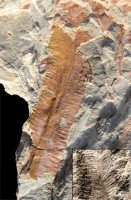 belongs to the very old order of the Marattiales, which includes also the fern tree Psaronius, with its Pecopteris leaves, from the late Carboniferous and the Permian. The still living species in this group are all tropical and their habitat is restricted to southeast Asia. Of Marattiopsis intermedia mostly detached leaflets are found. These were part of large, several times branching leaves. The leaflets are elongated with parallel borders and they have secondary veins standing perpendicularly to the main vein. On the fertile leaflets elongated sori (clusters of sporangia) are situated at the tips of the side veins. |
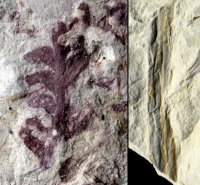 Todites
princeps Todites
princeps belongs to another ancient order, i.e. the one of the Osmundales (Osmunda regalis = royal fern). About 16 species in this group are still existing, whereas 150 fossil species are known. In the Plant sandstone, leaves as well as stems and rhizomes have been found of Todites princeps. The pinnules (the smallest leaflets) are attached to the axis with the entire base and often they are connected with each other. The pinnae have parallel sides as a whole but are narrowing to the top. The stems can be very thick. The picture (click on it) shows a young stem. It is characterized by a scalelike structure. |
| The remaining ferns belong to the leptosporangiate group. This is a more 'modern' group with small sporangia with a thin wall, containing relatively few spores. |
| Phialopteris tenera (not pictured) is a very fine little fern which is very rare. Only a short time ago the fertile parts with spores in the sporangia were found for the first time. |
| Selenocarpus muensteri (not pictured) is also a very rare plant. It has a rhizome, giving birth to new stems about every 2 cm. These are forked at the top and each branch bears a couple of subleaves which are attached in one point. |
Phlebopteris angustiloba
 belongs to the Matoniaceae family of which only two species are in existence (in Malaysia). Phlebopteris angustiloba is easily recognizable by the long, narrow, each other touching pinnae with an almost square and somewhat convex subdivision. Often the leaf seems to be undivided. Under each little ball a sorus (a group of sporangia) is attached. |
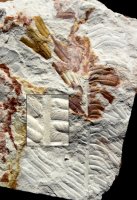 Phlebopteris
muensteri Phlebopteris
muensteri has pinnae, which are comparable to those of preceding species, but they are standing more free from each other. That's why the leaf looks very different. The pinnae are undivided and connected at the base. See the inset in the picture (click on it). The leaves as a whole are palmate divided. |
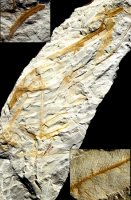 Thaumatopteris
brauniana Thaumatopteris
brauniana belongs to the Dipteridaceae. Only two genera of this family with 12 (tropical) species are still in existence. The leaves have a reticulate venation, a rare characteristic in ferns, but typical for this family. The pinnules of T. brauniana are strongly elongated and show indentations and lobes at the top. The pinnules are about perpendicular to the axis and they are standing free from each other. Very often the lobed apical part of the leaf is missing. |
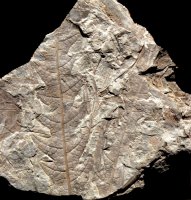 Dictyophyllum
nilssonii Dictyophyllum
nilssonii is a member of the same family as the preceding species and has a striking reticulate venation. This resembles the venation of a modern, angiosperm plant. The leaves as a whole were very large and nearly always only fragments are found. These are easy to recognize because of the polygonal meshes, formed by the veins. The petiole of the leaf forks at the top and each of the two branches bears a couple of pinnae. These pinnae are deepy incised and very variable in shape. |
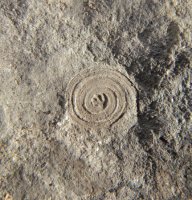 Spiropteris SpiropterisThis is the name of the coiled young fern leaflets (also called croziers). |